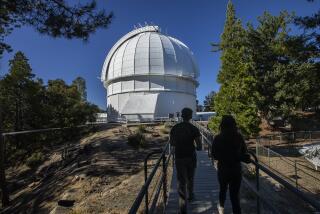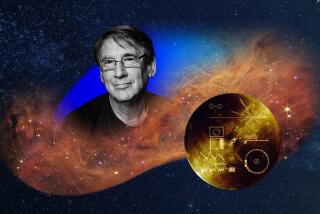Hubble’s Lens Has the Galaxy in Its Site
- Share via
Remember Hubble?
Several years before the Pathfinder mission justifiably captured the attention of millions with its remote-controlled exploration of Mars, the Hubble Space Telescope was launched into orbit to peer more deeply into space and back further into time than ever before possible.
Best known for an embarrassing flaw and then heroic resurrection as a scientific instrument, Hubble has been quietly orbiting the Earth every 75 minutes since 1990, taking pictures of objects chosen by astronomers and physicists. Earlier this year it captured an image so far away that it goes back 13 billion years, not long after time as we know it began.
Breathtaking stuff. You can see the historic photos and read all about it in terms even we nonscientists can mostly understand at https://oposite.stsci.edu/edu/pubinfo/Pictures.html, a Hubble site operated by NASA’s Space Telescope Science Institute.
You have to be a bit patient. The site gets an A+ for its bountiful pictorial and scientific riches, but its creators might have to be held back a grade in the Web site organizational department.
The site opens with a group of tantalizing, small images, but no explanation of what they show or what they lead you to if you click on them. Also on the page are some text links, with alluring titles such as “1997 Releases.”
OK, so they’re scientists, not advertising mavens.
If you click around at random, you’re sure to find some fascinating stuff. But here’s a guided tour of some of the awe-inspiring links.
The first one is of use only if your Web browser can handle Java (if you have a fairly recent copy of Netscape or Internet Explorer, you’re probably OK). You start out by clicking on the small picture of the Hubble spacecraft, which leads you to a page with many more links. Here you can click on links to read about the history of Hubble.
But eventually, you’ll want to click on the link labeled, “Where is HST?”
That takes you to the “Satellite Tracking” page. Scroll down and click on the “Spacecraft” graphic, and then sit back for a moment to let Java go to work.
Your reward for all this clicking is a map of the world that shows the current location of not only Hubble above the Earth, but also Mir and a shuttle if one happens to be orbiting at the time.
There is another part of the site you should see, and probably the easiest way to get there is to simply put this address in your browser--https://oposite.stsci.edu/pubinfo/PR/96/23.html. Once there, you can see some incredibly beautiful images of a doomed star, Eta Carinae, that is coming to the end of its life with a sky show highlighted by explosions of huge, colorful clouds of gas and dust.
* Cyburbia’s e-mail address is [email protected].
More to Read
Sign up for The Wild
We’ll help you find the best places to hike, bike and run, as well as the perfect silent spots for meditation and yoga.
You may occasionally receive promotional content from the Los Angeles Times.







